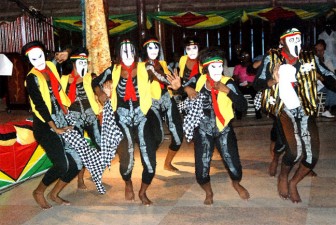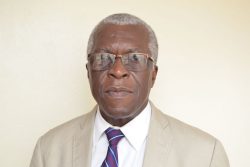Guyana’s National Dance Company (NDC) performed its Season 32 on October 22 – 23, 2011 on the theme Hello Darkness. The production, directed by NDC producer and choreographer Vivienne Daniel, with narration by hostess Shevonne Semple, focused on the theme of darkness in the first half with the second segment devoted to two tributes: one to a great American dancer and the second to the International Year of People of African Descent.
This comment will not be on all aspects of the production and its contents, but just to mark a few elements of significance as they relate to the Dance Company and to dance in Guyana. An interesting factor is the historical context of dance in Guyana and the contribution of the NDC, the audience for dance and its popular influences, the NDC’s response to contemporary dance, the survival of the company and its particular strengths.
 Hello Darkness was the performance of the 32nd Dance Season of the National Dance Company of Guyana, and this hints at its place in the history of dance in the country. This will only be briefly touched since it has already been the subject of discussion here. The 32 years of the NDC means it is the oldest surviving company in the country (followed quite closely by the Nadira and Indira Shah Dance Troupe). It was created at the time in the 1970s when Guyana as a nation began to set down institutions for formal training in the arts with the establishment of National Schools of Art and of Dance. The school established a deep foundation for the performing arts and the company that was founded a few years afterwards would be the professional arm for public performance, research, experimentation and artistic advancement of the form.
Hello Darkness was the performance of the 32nd Dance Season of the National Dance Company of Guyana, and this hints at its place in the history of dance in the country. This will only be briefly touched since it has already been the subject of discussion here. The 32 years of the NDC means it is the oldest surviving company in the country (followed quite closely by the Nadira and Indira Shah Dance Troupe). It was created at the time in the 1970s when Guyana as a nation began to set down institutions for formal training in the arts with the establishment of National Schools of Art and of Dance. The school established a deep foundation for the performing arts and the company that was founded a few years afterwards would be the professional arm for public performance, research, experimentation and artistic advancement of the form.

Some factors have been responsible for the development and the quite healthy state of dance in Guyana. These are the National School of Dance, the National Dance Company, Cuba, Haiti, Carifesta 1972, India, Hinduism and the oral tradition. Guyana’s close relations with Cuba pushed official interest in training and the development of professionalism assisted by Cuba’s strength in dance and its willingness to lend experts to Guyana. Similarly, friendship with Haiti allowed the services of such experts as Lavinia Williams, added to the connections and boost provided by the first Carifesta in Guyana in 1972. Scholarships to India and the later activities of the Indian Cultural Centre in Georgetown, as well as the deep tradition of Hindu festival activities across the country strengthened and advanced Indian dance. Both African and Indian religious and cultural practices in the oral traditions kept certain dance rituals alive, but this has been the weakest of the contributing factors.
The dance school and its semi-professional company led to several trained and experienced persons who could branch out to form new troupes and companies and teach dance to many others. Dance performances multiplied, especially at the National Cultural Centre and a new audience for dance was created. Dance became popularised, aided by Hindu activities and the equal interest and spread of Indian dance. There arose a brand of popular dance to meet the increasing audience, especially the exploits of the Classique Dance Company and the work of its leading personalities Clive Prowell and Leslyn Lashley. By this time the popular audience had become another important factor.
In the production of its annual Season the NDC has been attempting to respond to the growing and changing influences while trying to keep pace with modern and contemporary dance, and even to innovate. However, the national company has had other issues, such as those relating to its own survival. While it has been partly responsible for providing the enabling environment for the multiplicity of new groups, it has had problems retaining the services of its talented and experienced members which can make it the strongest company in the country. But there has been a rapid turnover in membership.
The main cast of Hello Darkness was the present company members Maresha Arthur, Mariela Bennett, Joseph Bobb, Jerusha Dos Santos, Clifford Douglas, Maranda Drakes, Mwanza Glenn, Nicola Hinds, Tamisha La Rose, Kijana Lewis, Maurissa McPherson, Shevonne Semple, Tecona Welcome, Mario Wilson and Falonna Hall. They were supported by the Company’s associate members in addition to some senior students in the National School.
It is noted that experienced talent who had risen to high virtuosity and solo performance are still there, such as Jerusha Dos Santos, Nicola Hinds, Maresha Arthur and Mario Wilson, while Shevonne Semple has returned. Also noteworthy is the addition of new male dancers to add to Wilson and Kijana Lewis who have become very strong leads. But the company has had to draw on the pool of rising trainees from among the best of the school for associate members who, one by one, join the company to replace those who leave. A too rapid turnover in this cast can retard the maintenance of a strong company and national dance itself.
While coping with this, the NDC has attempted to keep pace with the dynamics of contemporary dance and the audience factor. Dance Season 32 is in part a response to the increasing popular influences and a desire to retain the interest of the audience, which is in great part, the popular audience. Hello Darkness reflects a degree of diversification and the use of the company’s assets in meeting what it sees as audience appeal. For example, live singing, rather than recorded music was used as accompaniment in a few dances, and there were vocal narratives to aid meaning and theme in between some pieces. Miss Semple, who is an excellent singer and elocutionist served in both capacities. She should now reassert her command of dance.
Another strategy was the use of a plot to bear out the theme of ‘darkness‘ such as sections titled ‘Forces of Life‘ and ‘the Wheels of Blame,’ with dances which carried a story-line of family strife, domestic conflicts and tragedy. When this is done there have to be devices to aid audience understanding and there were dramatic sets, scenes, with dance sequences which very often reverted to mimes. These were not the most profound moments of the production despite the intended audience appeal.
In addition, some choreographies were given high entertainment attributes, such as S.C.A.R.Y. with its humorous appeal, audience involvement and use of the grotesque. Here again, the NDC utilised another of its assets, in this case Kijana Lewis, whose position on the Guyanese stage never ceases to be noteworthy. He now bestrides local dance like a colossus and is in addition, perhaps the fastest rising actor in the dramatic theatre. These cause him to be in great demand and, ironically, in great danger. He has pronounced stage presence and audience appeal and is effective in comedy. But the NDC will not want to over-use him in humorous roles as they threaten to do now, since they would not want such an important dancer to become a standard comic. For the same reasons Lewis might wish to be more selective in his acceptance of sundry roles in plays. He should maintain and pursue his potential to become a distinguished dancer and actor.
The real strengths of the NDC were on show in the sequence Hallelujia Junction, which included Homage 2, taken from Alvin Ailey’s Revelations. It was a tribute to the great choreographer, the Rex Nettleford of New York. Director/choreographer Vivienne Daniel has a particularly keen sense of theatre which she has often managed to pass on to her students. The NDC displays this feel for the dramatic in performances other than the humorous or popular. They were at their best in Homage 2, demonstrating that their place in local dance is to interpret on stage memorable choreography with depth and meaning. They looked the part in mood, technique and meaning supported by adequate costuming.
This national company, having already made contributions to the advancement of dance in Guyana, certainly exhibited what their role should be:- To research and study dance, to sharpen disciplined technique, to explore the imagination for the production of eloquent choreographies so as to educate and entertain an audience with dance at the highest levels.









